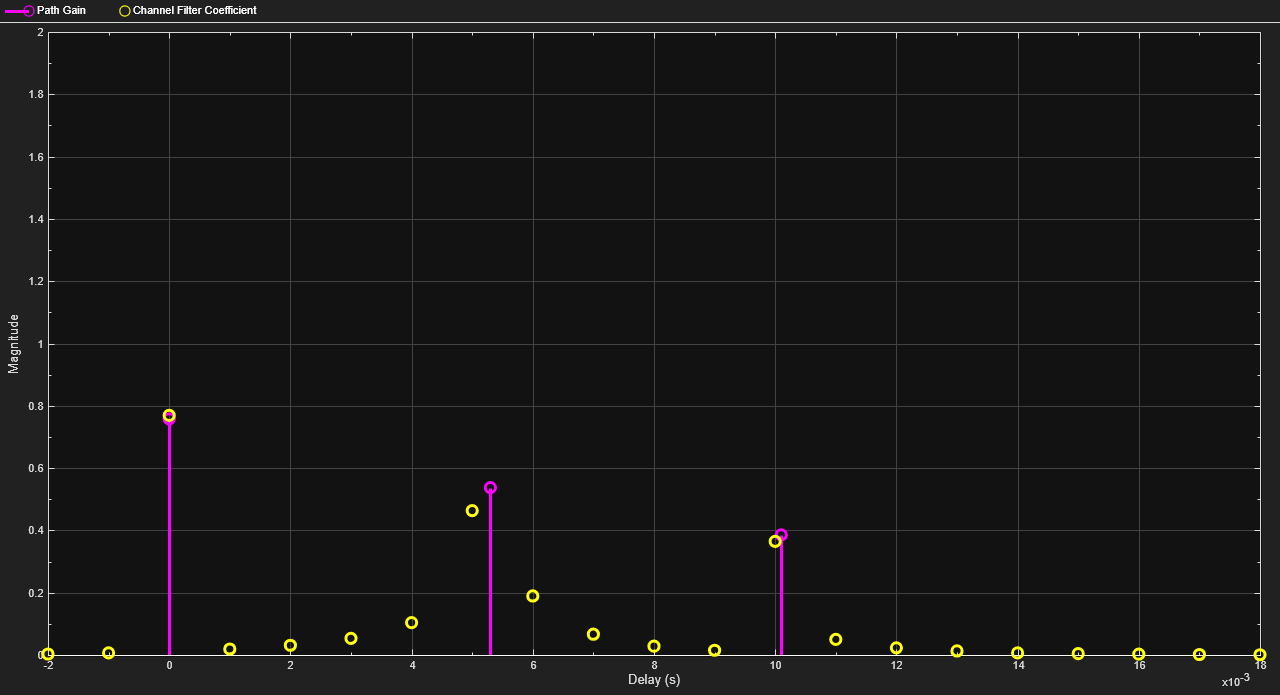channelDelay
Channel timing delay
Description
[
computes the channel timing delay by finding the peak of the channel impulse response. The
function reconstructs the impulse response from a channel path gains array and a path filter
impulse response matrix. The function returns the channel timing delay in samples, and the
channel impulse response magnitude. For more information, see Channel Delay and Magnitude Computation.delay,mag] = channelDelay(pathGains,pathFilters)
Examples
Configure a 2-by-2 MIMO channel. Use the info object function to retrieve the path filters.
chan = comm.MIMOChannel('SampleRate',1000,'PathDelays',[0 1.5e-3], ... 'AveragePathGains',[1 0.8],'RandomStream','mt19937ar with seed', ... 'Seed',10,'PathGainsOutputPort',true); chanInfo = info(chan); pathFilters = chanInfo.ChannelFilterCoefficients;
Compute the path gains by passing an impulse through the channel.
[~,pathGains] = chan(ones(1,2));
Compute the channel timing delay, specifying the retrieved path filters and computed path gains.
delay = channelDelay(pathGains,pathFilters)
delay = 6
Compute and show the relative timing delay for a Rayleigh channel over time.
Create a comm.RayleighChannel System object™ configured with three paths and impulse response visualization enabled.
chan = comm.RayleighChannel; chan.SampleRate = 1e3; chan.PathDelays = [0 5.3e-3 10.1e-3]; chan.AveragePathGains = [0.1 1 0.5]; chan.PathGainsOutputPort = true; chan.RandomStream = 'mt19937ar with seed'; chan.Seed = 1; chan.Visualization = 'Impulse response'; chan.MaximumDopplerShift = 1;
Use the info object function to retrieve the Rayleigh channel path filters. In a loop, pass a static signal of all ones through the Rayleigh channel. The channelDelay function uses the channel path gains array from each pass through the channel and the path filter coefficients, chanInfo.ChannelFilterCoefficients (returned by the info function) to compute the relative channel timing delay. The impulse response varies for each iteration. The impulse response for the last iteration is shown here. The delay vector shows the relative channel timing delay computed for each iteration.
chanInfo = info(chan); numIter = 12; delay = zeros(1,numIter); for p=1:numIter [~,pg] = chan(ones(1e3,1)); delay(p) = channelDelay(pg,chanInfo.ChannelFilterCoefficients); end

delay
delay = 1×12
12 7 12 2 12 7 12 7 7 7 2 2
Input Arguments
Channel path gains, specified as an Ncs-by-Np-by-Nt-by-Nr array, where:
Ncs is the number of channel snapshots.
Np is the number of paths.
Nt is the number of transmit antennas.
Nr is the number of receive antennas.
If any element in pathGains is NaN, the
function assumes that no path exists between the transmitter and the receiver.
Data Types: double | single
Complex Number Support: Yes
Path filter impulse response, specified as an Np-by-Nh matrix. Np is the number of paths, and Nh is the number of impulse response samples.
Data Types: double | single
Complex Number Support: Yes
Output Arguments
Channel timing delay in samples, returned as an integer. This value represents the
number of samples of delay relative to the first sample of the channel impulse response
reconstructed from the pathGains and
pathFilters inputs. The function computes the channel timing
delay by finding the peak of the composite channel impulse response. For more
information, see Channel Delay and Magnitude Computation.
Channel impulse response magnitude for each receive antenna, returned as an Nh-by-Nr matrix. Nh is the number of impulse response samples, and Nr is the number of receive antennas. For more information, see Channel Delay and Magnitude Computation.
More About
The computation of the channel delay and impulse response magnitudes uses the composite channel impulse response.
The composite channel impulse response results from averaging the impulse response across all channel snapshots as represented in the path gains array. The input path gains array must be of the format Ncs-by-Np-by-Nt-by-Nr , where:
Ncs is the number of channel snapshots.
Np is the number of paths.
Nt is the number of transmit antennas.
Nr is the number of receive antennas.
The channel timing delay, output as a single value, is relative to the first sample of the channel impulse response. The function computes this value by finding the peak of the composite channel impulse response. The composite channel impulse response is the summation of the impulse responses across all transmit and receive antennas.
The receive impulse response magnitudes are output as an Nh-by-Nr matrix. Nh is the number of impulse response samples, and Nr is the number of receive antennas. To compute the receive impulse response magnitudes,
Path gains are summed across all channel snapshots.
The contribution from each path is added to the channel impulse response across all transmit and receive antennas.
The transmit antenna paths are combined in the channel impulse response array, leaving a matrix of impulse response samples versus receive antennas.
Extended Capabilities
C/C++ Code Generation
Generate C and C++ code using MATLAB® Coder™.
This function supports GPU array inputs. For more information, see Run MATLAB Functions on a GPU (Parallel Computing Toolbox).
Version History
Introduced in R2020aThe channelDelay function adds support for gpuArray (Parallel Computing Toolbox) object processing to run code on a graphics processing unit
(GPU).
See Also
comm.MIMOChannel | comm.RayleighChannel | comm.RicianChannel
MATLAB Command
You clicked a link that corresponds to this MATLAB command:
Run the command by entering it in the MATLAB Command Window. Web browsers do not support MATLAB commands.
웹사이트 선택
번역된 콘텐츠를 보고 지역별 이벤트와 혜택을 살펴보려면 웹사이트를 선택하십시오. 현재 계신 지역에 따라 다음 웹사이트를 권장합니다:
또한 다음 목록에서 웹사이트를 선택하실 수도 있습니다.
사이트 성능 최적화 방법
최고의 사이트 성능을 위해 중국 사이트(중국어 또는 영어)를 선택하십시오. 현재 계신 지역에서는 다른 국가의 MathWorks 사이트 방문이 최적화되지 않았습니다.
미주
- América Latina (Español)
- Canada (English)
- United States (English)
유럽
- Belgium (English)
- Denmark (English)
- Deutschland (Deutsch)
- España (Español)
- Finland (English)
- France (Français)
- Ireland (English)
- Italia (Italiano)
- Luxembourg (English)
- Netherlands (English)
- Norway (English)
- Österreich (Deutsch)
- Portugal (English)
- Sweden (English)
- Switzerland
- United Kingdom (English)